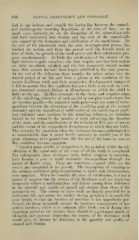Page 636 - My FlipBook
P. 636
646 DENTAL EMBRYOLOGY AND HISTOLOGY.
find in the incisors and cuspids the border-line between the enamel-
and dentine-germs receiving depositions of the salts of lime ; or, to
speak more correctly, we see the formation of the odontoblast-cells
and their conversion into dentine and the ends of the enamel-cells
into enamel by the formation and calcification of the ameloblasts. By
the end of the nineteenth week the same developmental process has
reached the molars, and from this period until the fortieth week, or
time of birth, the growth of the tooth-germs and their calcification pro-
gress simultaneously. At birth the calcification of the crowns of the
eight incisors is quite complete ; the four cuspids and four first molars
are fully two-thirds calcified, and the four temporary second molars
have their crowns for half their length solidified by the same process.
At the end of the following three months the infant enters into the
critical period of its life, and from a glance at the condition of the
twenty deciduous teeth and their progressive developmental changes it
is fair to assume that this condition has not a little to do with the vari-
ous abnormal systemic lesions or disturbances to which the child is
liable at this age. In close proximity to the sharp and irregular edges
of the calcifying extremity of each partial or complete tooth-crown lies
the vascular papilla—the primitive tooth-pul})—and any want of corre-
spondence betAN'een the absorption of the overlying gum at the coronal
extremity and the deposition of solid matter at the calcifying or papil-
lary extremity must produce, by this retarding influence, an irritation
limited in its extent by the number of teeth advancing, the duration
of the cause, and the ramifications of the trifacial or fifth pair of nerves
and the extent of the sympathetic disturbances to which they are liable.
The necessity for operation when the irritation becomes pathological is
so unmistakable that it seems hardly necessary to remind you of the
great advantage to be gained from the free use of the lance as soon as
this condition becomes apparent.
" Another point worthy of recognition is the period at which the cal-
cification of the apical ends of the roots of all the teeth is completed.
Not infrequently these deciduous teeth, before eruption is complete,
have become a prey to rapid molecular decomposition through the
agency of dental caries. Pulps are sometimes exposed while yet the
root is not completed in its growth. The impropriety of resorting to
the ordinary method of pulp-devitalization is, under such circumstances,
very apj>arent. When we consider the time of calcification, it is not a
matter of surjirise that the crowns of the deciduous teeth are much less
frequently subject to maH'ormations and defects arising from deficiency
in tlie (juantity and quality of enamel and dentine than those of the
permanent set. The crowns of these teeth are largely provided for in
embryonic life, and unless the mother during gestation is in markedly
poor health, so that the function of nutrition is but imperfectly per-
formed, the foetus invariably escapes the necessary consequences of im-
perfect nutrition, which is so conmion after birth ; yet if during this
im]K)rtant period to the embryo there should be a ])rolonged attack of
ill-health and systemic depression, the crowns of the deciduous teeth
would give its history by deficiency in the quantity and quality of
enamel and dentine.


